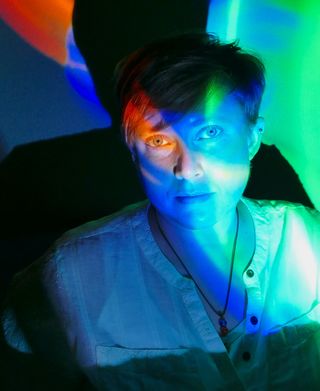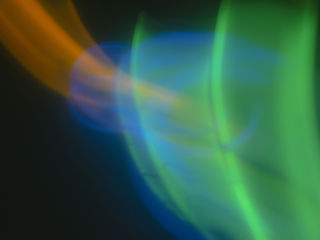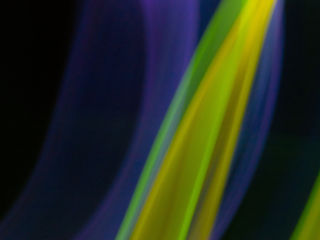Synesthesia
That Which Cannot Be Said with Words
Artist Carrie C. Firman adds to her stunning collection depicting synesthesia.
Posted September 7, 2018

One of the first people profiled in this blog when it began six years ago is the synesthete and artist Carrie C. Firman. Ms. Firman's gorgeous artistic depictions of synesthesia -- lit and liquid and motile -- resonate with many true synesthetes as important and authentic representations of our inner worlds. I personally find her work museum-quality.
Lots has been happening for the talented artist -- now a tenured associate professor of graphic design at Edgewood College in Madison, WI -- and frequent guest professional in Iceland.
I thank her for this exclusive first look at the continuation of her iconic series, "That Which Cannot Be Said With Words." Several panels from it are shown throughout the following Q & A. The title is so apt and expresses how verbiage fails sometimes to capture the experience of bonus senses that is synesthesia.
What made you go back to "That Which Cannot Be Said With Words"? What did you want to say in this next set?
CCF: I've never been able to mentally/emotionally put this project down, and never saw it as finished after the previous installments. Given a very hectic few semesters and a busy summer, it was fulfilling to get some cheap supplies and create several new works in a short amount of time (with editing later). Most synesthetes I know, especially those in creative careers, tell me they notice fleeting things that look familiar to them, and I'm no exception. Also, I tend to go back and forth between the more "designerly" works, with smooth edges and attention to correct color and position, and these gestural, quick works which are meant to portray the aesthetic. I always struggle with the cultural pressure of exact representation. I feel protective of my visualizations, and that it would be a crushing quest for perfection to do that, which doesn't have room in my life or artistic practice.
Since we last profiled you, so much has happened in the synesthesia realm. What do you make of all the developments?
CCF: The key thing that has happened is accurate visibility. I'm delighted to be sent the same article by several people, popping up and being picked up by mainstream and pop culture media outlets. The use of language with negative connotation is still around, but is decreasing as synesthetes are being interviewed more. The use of the word "condition" still riles me. As someone with several "conditions," I can tell you synesthesia is nothing like the rest!
Can you tell me about your (tenured!) teaching position? Do you ever find students who are synesthetes?

CCF: I received tenure in last academic year's promotion cycle, and it was effective this month! I'm honored to be included in this group of outstanding, committed colleagues. Yes, I have had students give a variety of reactions when I try to explain some of my work. It currently doesn't play a large part in my teaching, simply due to the type of classes. Actually, when I run into it the most is when trying to override my personality associations with color when viewing and critiquing student work. Just because I think pink is a vapid, lazy, self-obsessed color that takes credit for things it didn't do doesn't mean it might not work in a design project! I have to rely on my textbook knowledge and experience with the rules of color theory and our cultural associations with those systems.
Iceland has become so important to you -- what have you been learning there on your trips and what do you bring back from it?

CCF: Iceland is indeed so special. It gives me time, quiet, adventure, and new input on my work when doing group residencies. For me, dislodging myself from the comforts (and discomforts) of home lets me set new priorities and a fresh, even if temporary, flow of life. I have stayed in a variety of places, CouchSurfing with those younger and older than me, sharing old and new houses with fellow artists in residence from across the globe, short stays in guest houses and converted garages, and hotels from from family-run one-story buildings to a several-story small-roomed conventional European setup. The landscape, of course, is sublime, dominating, and every changing in the unique light and weather. Unique animals are part of life and history. The arts thrive. The culture is far less judgmental on the expectations of age, gender, reproduction, and self-expression. Hot tubs and swimming pools in every town let me continue to care for my chronic pain with laps, stretches, and soaks. In Iceland, I'm free. I try to soak up all that freedom, expression, and exploration and hold on to it when I come back.
I got to take students and a couple faculty with me this summer for 8 days, adding a new dimension to my 3 previous trips. Watching them learn, enjoy, and be amazed was incredibly fulfilling. The always-on leadership role may have been tiring, but the trip was so long in the making and went so well that I definitely came out of it feeling joyful – especially after hanging up an exhibition that highlights their photography in our beautiful art building.
What's next for you?

CCF: I want to live under, observe, photograph, and experiment digitally with the Northern Lights. This edition of TWCBSWW, especially, has a similar aesthetic, and I am always looking for new light sources to work with. Having heard other synesthetes concur that the Aurora Borealis shares some aesthetic similarities with some of their visualizations, I think this will be a successful project. As I do not make art to sell it, or to exactly describe my solitary experience, I value highly creating works that can be accessed and shared online and at conferences, which can educate others, give synesthetes and researchers visuals to use as examples, and serve as a point of discussion about synesthesia.


